TOPPS AND BOWMAN CARDS DURING THE “WAR YEARS” of 1951
to 1955

Who
Made it onto the Cardboard and Who Didn’t
By
George Vrechek
Litigation between Topps and Bowman coupled with unusual situations like the Korean War draft and a requirement that bonus babies remain on major league rosters created an interesting collage of players appearing on baseball cards during the cardboard “war years” of 1951 through 1955. Over the years those cards have become part of our memory bank. You look at the cards and envision the players in action during that season. However, sometimes our memories need a bit of a reality check. Let’s examine a few of my own memories about the cards and the players.
Cardboard Memories
Looking at grizzled veteran reliever Joe Page on his 1952
Topps card, you can picture him coming in to save the day for Whitey Ford. Too
bad Ted Williams was away in the service with no cards in 1952 and 1953 but at
least we still had Willie Mays playing and pictured on a Topps card in 1953.
The O’Brien twins card in the 1954 Topps issue was certainly unique, two
players for the price of one. You could envision the O’Briens getting
Comparing Cards to Players Each Year
I began my research by putting together lists of Topps and Bowman cards issued in 1952 and comparing the players pictured to those actually appearing in major league baseball that year according to the wonderful on-line source, Baseball Almanac at http://www.baseball-almanac.com/ . I developed several categories. For players appearing in the majors I listed those who were on both Topps and Bowman cards (e.g. Mickey Mantle), those who were only on Topps cards (e.g Jackie Robinson) and those who were only on Bowman cards (e.g. Stan Musial). The next category consisted of players who were in the majors in 1952 and had baseball cards at some time, but just not in 1952 (e.g. Satchel Paige). The final category were the poor souls who appeared in the majors in 1952 but never had a “regular” card (think “Putsy” Cabellero.). I then looked at the cards issued in 1952 that were of individuals not appearing in major league baseball in 1952. Some of these people were coaches and managers, others were players who appeared in years other than 1952, and finally the last category was that of players depicted on cards but who never appeared in a major league game.
|
|
1952 |
1953 |
1954 |
1955 |
|
Players - appearing on both Topps
and Bowman |
210 |
114 |
82 |
41 |
|
Players - Topps only |
148 |
139 |
129 |
144 |
|
Players - Bowman Only |
24 |
90 |
136 |
210 |
|
Players - no card that year but
had card in other years |
104 |
112 |
150 |
146 |
|
Players - no cards ever |
69 |
89 |
43 |
64 |
|
|
|
|
|
|
|
|
555 |
544 |
545 |
605 |
It was so much fun going through 1952 I zipped along through the rest of the years 1953 through 1955 when Bowman and Topps were duking it out over players’ authorizations. The data-base assembly was not the hard part thanks to modern technology and Baseball Almanac. The hard part was sorting out the players. You expect to do a little work to separate two Hal Smiths, three Bob Millers, Joneses, Johnsons and Wilsons but you don’t expect to be hunting down two Dixie Howells who played at the same time. It seemed as logical as having two Boog Powells or two guys named Heinie Manush. (A special thank you for the baseball card featuring a third Robert Smith which added “Riverboat” Smith.) And then there were the nicknames, Red Munger, Red Wilson, Red Kress, and Red Schoendienst, which made it a little harder to match up given and playing names. Finally the guys with three names, as far as the computer is concerned, Pee Wee Reese, Ebba St. Claire, Vinegar Bend Mizzel and Ed Fitz Gerald, were an additional special handling requirement.
 Before I began my number-crunching
exercise I assumed that I would find that Bowman had started to give up by
1955, including umpires, coaches, and unknown players in their issue to come up
with enough cards. I expected that I would find more players exclusively with
Topps by 1955 like Ted Williams, Duke Snider, and Jackie Robinson. While it was
true that Topps had exclusive deals with some of the stars, it was actually
Bowman ahead in the battle for players being depicted exclusively on their
cards. By 1955, for the first time, Bowman had a large issue of 320 cards and more
players who appeared in the majors that year on their cards (252) than Topps
(182.) Bowman also had 210 active major leaguers exclusively on their cards
versus only 144 for Topps. From a statistical viewpoint it was Topps who was
starting to get on thin ice with an issue of only 206 cards with names like Kipper,
Qualters and Kraly sounding more like a law firm.
Before I began my number-crunching
exercise I assumed that I would find that Bowman had started to give up by
1955, including umpires, coaches, and unknown players in their issue to come up
with enough cards. I expected that I would find more players exclusively with
Topps by 1955 like Ted Williams, Duke Snider, and Jackie Robinson. While it was
true that Topps had exclusive deals with some of the stars, it was actually
Bowman ahead in the battle for players being depicted exclusively on their
cards. By 1955, for the first time, Bowman had a large issue of 320 cards and more
players who appeared in the majors that year on their cards (252) than Topps
(182.) Bowman also had 210 active major leaguers exclusively on their cards
versus only 144 for Topps. From a statistical viewpoint it was Topps who was
starting to get on thin ice with an issue of only 206 cards with names like Kipper,
Qualters and Kraly sounding more like a law firm.
The Player Agreements
Wikepedia is a good source for many things including the histories of Topps and Bowman. From Wikepedia we learn that in 1950 Topps used an agent, Players Enterprises, to sign players to contracts for the 1951 set. Topps sold the 1951 cards with taffy to avoid possible litigation with Bowman had they packaged chewing gum with cards. However, like Bowman whose contracts called for option years, Topps contracts called for a renewal option to sell cards of the players again but with chewing gum in the future (1952). (The taffy proved problematic.) Players got plenty of bubble gum from both companies. The initial idea was to help sell their gum products and not necessarily sell cards. The companies tried to enter into either exclusive or non-exclusive contracts with players between 1951 and 1955 to depict them on baseball cards. Thus began litigation between Topps and Bowman over who could sell what with whose picture.
According to Wikipedia the
litigation involved the questions of “the dates when a given player signed
contracts with each company, and whether the player's contract with one company
had an exception for his contract with the other. As the contract situation was
sorted out, several Topps sets during these years had a few "missing"
cards, where the numbering of the set skips several numbers because they had
been assigned to players whose cards could not legally be distributed.” (The
Richie Ashburn 1953 Topps non-card)
Let’s Ask Sy Berger
However, an even better source of information on Topps is Sy Berger who took my call to answer questions about what happened and why. Eighty-five year old Sy Berger has been called the “father of the modern baseball card” because of his significant role at Topps in the early years, signing players, designing the cards, writing the backs, and checking the statistics. I learned he joined the company in 1947 as a 24-year old and took over from Players Enterprises by going into clubhouses to sign players to agreements starting in 1951.
Topps didn’t just stroll in the front door of baseball
locker rooms and start signing players, they had to work at it. Once in, Topps
was successful in signing players, even if they had already signed with Bowman.
It wasn’t too long after Sy Berger got into the Giants’ locker room that he
befriended a discouraged young rookie named Willie Mays, who had started his
career going 1 for 25. They have been friends ever since. Once in the door, Sy signed just about
everyone. He made sure he talked to the players’ reps on each team like Jerry
Coleman and Eddie Yost. He would catch the visiting teams as they came through
The 1952 Carryover of 1951 Players
 Topps lineup for 1952 now made more sense to me. Players Enterprises signed
104 players to appear in the two 1951 Topps sets, the Red Backs and Blue Backs.
Topps used every one of the 1951 players that they could again in their 1952
set. The only 1951 Topps players not appearing in 1952 were Bobby Doerr, who
retired, and Ralph Kiner, who was a star tangled up in the new Topps/Bowman
dispute. Kiner was back with Topps as well as Bowman in 1953 but then was back
to Bowman only in 1954 and 1955. (I once traded my entire collection of cards
for one Ralph Kiner 1953 Topps card. I was eight at the time.) Topps even used
Joe Page again in 1952 although the Yanks demoted him to the minors in May 1951;
thus he could not have come in, as I imagined, to relieve Whitey Ford in 1952; besides,
Ford was in the service the entire year. If someone was going to use a retired
player in 1952, Joe DiMaggio would have been a nice choice; he hadn’t appeared
since his obscure cartoon card of 1949 M&P. I’m guessing that he held out
for more than what Bowman was offering and that he never got anything from the
M&P issue. Another odd case was that of Ben/Sam Chapman. Sam was finishing
out his playing career with the Indians in 1951 when he appeared in the Topps
Blue Back set. His picture shows up again in the high-numbered 1952 set but
with the name and bio of coach Ben Chapman who was probably not even under
contract with Topps. The other 1951 players appear in lower series 1952 cards.
Topps lineup for 1952 now made more sense to me. Players Enterprises signed
104 players to appear in the two 1951 Topps sets, the Red Backs and Blue Backs.
Topps used every one of the 1951 players that they could again in their 1952
set. The only 1951 Topps players not appearing in 1952 were Bobby Doerr, who
retired, and Ralph Kiner, who was a star tangled up in the new Topps/Bowman
dispute. Kiner was back with Topps as well as Bowman in 1953 but then was back
to Bowman only in 1954 and 1955. (I once traded my entire collection of cards
for one Ralph Kiner 1953 Topps card. I was eight at the time.) Topps even used
Joe Page again in 1952 although the Yanks demoted him to the minors in May 1951;
thus he could not have come in, as I imagined, to relieve Whitey Ford in 1952; besides,
Ford was in the service the entire year. If someone was going to use a retired
player in 1952, Joe DiMaggio would have been a nice choice; he hadn’t appeared
since his obscure cartoon card of 1949 M&P. I’m guessing that he held out
for more than what Bowman was offering and that he never got anything from the
M&P issue. Another odd case was that of Ben/Sam Chapman. Sam was finishing
out his playing career with the Indians in 1951 when he appeared in the Topps
Blue Back set. His picture shows up again in the high-numbered 1952 set but
with the name and bio of coach Ben Chapman who was probably not even under
contract with Topps. The other 1951 players appear in lower series 1952 cards.
“Last Year” in Case They Didn’t
Sell
Topps didn’t want
to get stuck with a surplus of expensive product if the cards didn’t sell well.
Sy Berger wrote all the card backs and statistics at home in the evening. He
intentionally labeled the 1951 stats as “last year;” if it took awhile to sell
the cards they wouldn’t appear to be too dated. It wasn’t until Topps saw that
the cards were a success that they started printing the last series.
Unfortunately, they waited too long. As a kid I remember seeing low-numbered
cards packaged in clear cellophane years later, but the high-numbered cards
were not among them in our neighborhood. High-numbered stars Mantle,
Campanella, Reese, Durocher, Mathews and Jackie Robinson wound up being dumped
in the ocean by Topps.



 The Majority of 1952 Players are in Both Sets
The Majority of 1952 Players are in Both Sets
 In 1952 there were 148 players who appeared only on Topps cards, notables:
Jackie Robinson, Ted Kluszewski, Hank Sauer, Eddie Mathews, versus just 24
players who appeared strictly on Bowman cards: Furillo, Maglie, Musial,
Piersall, Kiner and Nellie Fox. The majority of players (210) appeared in both
sets and included: Mantle, Mays, Snider, Reese, Rizzuto, Campanella, and Feller.
Neither manufacturer had Satchel Paige who had been released by
In 1952 there were 148 players who appeared only on Topps cards, notables:
Jackie Robinson, Ted Kluszewski, Hank Sauer, Eddie Mathews, versus just 24
players who appeared strictly on Bowman cards: Furillo, Maglie, Musial,
Piersall, Kiner and Nellie Fox. The majority of players (210) appeared in both
sets and included: Mantle, Mays, Snider, Reese, Rizzuto, Campanella, and Feller.
Neither manufacturer had Satchel Paige who had been released by  players who weren’t actually in the majors that year. There were also 16
coaches or manager cards between the manufacturers; the majority of whom were
with the
players who weren’t actually in the majors that year. There were also 16
coaches or manager cards between the manufacturers; the majority of whom were
with the
Team Representation
It is interesting
to see what teams were represented on the Topps and Bowman cards in 1952. Topps
averaged 25 players/coaches per team and Bowman 16. However there were 33
Dodgers and 27 Yankees depicted by Topps compared to just 22 Senators and Browns,
not surprising given Topps’ location. Bowmans were pretty evenly distributed
among the teams, except for the poor Browns who had only 11 representatives.
The Browns had some 48 players play for them in the 1952 season. Why couldn’t
we at least get a card of immortal Brown prospect Dixie Upright (2 hits in 8 at
bats in 1953) or the recently retired old number 1/8th, Eddie
Gaedel?
 1953 Has More Exclusives by Company
1953 Has More Exclusives by Company
If 1952 was a
year for players to wind up on both Bowman and Topps, 1953 was the year that
they started to collect into three distinct camps: players depicted by both
manufactuers (114), Topps only players (139), and Bowman only players (90).
Bowman had the same bigger name exclusives from the prior year: Musial, Marion,
Piersall, Maglie, Furillo, and Fox. Topps had exclusives on Mays, Paige, and
Crandall, while other stars appeared on both manufacturers’ cards. Jackie
Robinson had a radio program partially sponsored by Topps during this period;
as a result he only appeared on Topps cards after 1951.
The chart in this
article shows a variety of players and their Topps or Bowman cards by year. If
the player didn’t appear in the majors during the year shown, their box is in
gray. The chart shows that while Willie Mays had a nice card with just Topps in
1953, he was in the military and didn’t appear in a game in 1953. Therefore my
memory of him as a Giant in 1953 was from the card and not reality. Ted
Williams had no cards in 1952 or 1953 but did actually appear (briefly) in the
majors in both years despite being in the service, stateside. Jerry Coleman was
in combat for most of 1952 and 1953 but appeared briefly both years as well and
had cards with both companies in 1952 but nothing in 1953. Hal Newhouser had
been an active pitcher with the Tigers since 1939. During the two years he made
brief appearances (1953 and 1955) he had a Topps card, but he had no cards in
1952 or 1954 when he was more active.
The Bowman issues of 1953 always
seemed modest to me compared to the Topps issue, probably because the black and
whites were not as widely distributed. Casey Stengel in that set and Musial in
the color set were the memorable cards. It wasn’t that the Bowman Sniders,
Mantles and Berras weren’t of interest, but Musial was not available again
until 1958. For those of us trying to keep our players rubber-banded in with
their teams, the 1953 Musial continued to stick out like a sore thumb among the
smaller 1957 Topps cards. His “scarce” 1953 Bowman was one of the few cards
priced at a premium (50 cents) by early dealers. Thank goodness we could
finally get plenty fresh Stan Musials in the final 1958 All-Star series when
Topps finally obtained a contract with Musial through the Cardinals.
 Topps and Bowman covered 343 of the 544 players appearing in the majors in
1953 and had only 29 cards of players who didn’t appear that year. Not too bad considering the problems created by
players drafted to serve in the Korean War during 1953 like Willie Mays, Bobby
Brown, Vern Law, and Dick Groat. Of the 201 players appearing in the majors in
1953 and not on a 1953 card , 112 eventually had cards (like Banks, Kaline, and
Ted Williams) while 89 appeared without ever getting a regular card, including
one year wonders: Yo-Yo Davalillo, Bobo Holloman, Barney Martin and Spider
Wilhelm. New York Giant regular Bobby Thomson, who had the “shot heard around
the world” in 1951, is mysteriously missing from the cardboard in 1953.
Topps and Bowman covered 343 of the 544 players appearing in the majors in
1953 and had only 29 cards of players who didn’t appear that year. Not too bad considering the problems created by
players drafted to serve in the Korean War during 1953 like Willie Mays, Bobby
Brown, Vern Law, and Dick Groat. Of the 201 players appearing in the majors in
1953 and not on a 1953 card , 112 eventually had cards (like Banks, Kaline, and
Ted Williams) while 89 appeared without ever getting a regular card, including
one year wonders: Yo-Yo Davalillo, Bobo Holloman, Barney Martin and Spider
Wilhelm. New York Giant regular Bobby Thomson, who had the “shot heard around
the world” in 1951, is mysteriously missing from the cardboard in 1953.
 1954 Two Williams and Two O’Briens
1954 Two Williams and Two O’Briens
1954 continued
the trend of players in three camps but this time Bowman finally started to
have more exclusives. Eighty-two players were on cards of both companies. Topps
had 129 exclusives and Bowman had 136. Combined, Topps and Bowman had cards of
347 of the 541 players appearing that year. Only 43 players appeared without
ever getting a card. Topps had a bigger issue than Bowman almost entirely due
to including 25 coaches and managers versus none in the Bowman set. As kids I
recall not being too enthused pulling a wrinkly coach I’d never heard of out of
the packs.
The big news was
that Topps had two cards of Ted Williams who was now back full time from
military duty. Topps got Williams to an exclusive by offering him $400 per year
for five years. Thereafter, Williams worked out a lucrative $5,000 agreement to
appear on the Fleer’s issue of 1959. Of course Bowman also had a 1954 card but
it disappeared quickly when Topps threatened legal action because their
contract was exclusive and Bowman didn’t really have an option year. Topps
would sign the players but sometimes they didn’t use them because they felt
their contract was unenforceable (The missing numbers in 1953 and 1955).


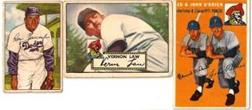 My memory of the O’Brien twins helping the Pirates out of the cellar in
1954 was a bit off. Even though they had a two-for-one Topps card in 1954, both
players were in the military all year and
My memory of the O’Brien twins helping the Pirates out of the cellar in
1954 was a bit off. Even though they had a two-for-one Topps card in 1954, both
players were in the military all year and
Players in Three Camps for
1955
In Bowman’s last
year of 1955 they actually had the most players (210) by far who appeared
exclusively on their cards and in the major leagues that year. Topps had
exclusives on 144. Only 41 players were in both sets - notables Aaron, Kaline,
Mays, Mathews, Rizzuto, and Berra. Topps again had Robinson, Williams, Spahn,
and, in the last series, Duke Snider. Bowman had their usual assortment of
Dodgers plus Mantle, Ford, and Feller. Bowman increased their set to include
320 players. Since Topps had exclusives on 144 players and there were only 400
players on opening day rosters, Bowman had to stretch a bit more. This unusual
situation enabled 31 umpires to have their one day in the cardboard sun. Bowman
had Bobby and Billy Shantz on one special card. You might think Bowman was
copying Topps 1954 O’Brien brothers card, but Bowman beat Topps 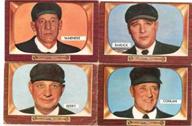 to the punch with multi-player cards in 1953 of Martin/Rizzuto and
Bauer/Berra/Mantle. Bowman threw in seven coaches and a record-high 31 players
who never made it to the big leagues in 1955, although it was nice to have one
last card of retirees Allie Reynolds, Johnny Pesky, Sid Hudson, and Preacher
Roe. Roe retired during the 1954 season but got traded to the Orioles anyway
during the winter. Bowman created a card of him as an Oriole although he never
wore the uniform. The good news was that, between the two manufacturers, 395
active players were depicted on cards. Another 146 players appeared in the
majors that year and made an appearance at some time on a baseball card.
Sixty-four players somehow managed to avoid either issuer. Anyone remember
seeing Jim Command, Joe Brovia, Bill Froats, Tom Gastall, Nick Koback, Mike Kume, Chuck Locke, Lynn
Lovenguth, Harry Malmberg, Felipe Montemayor, Tony Roig, Jerry Schypinski, Walt
Streuli, Dick Tettlebach, or Ozzie Van Brabant? I’ll bet that if they had a
baseball card, they would have been at least as famous as Memo Luna.
to the punch with multi-player cards in 1953 of Martin/Rizzuto and
Bauer/Berra/Mantle. Bowman threw in seven coaches and a record-high 31 players
who never made it to the big leagues in 1955, although it was nice to have one
last card of retirees Allie Reynolds, Johnny Pesky, Sid Hudson, and Preacher
Roe. Roe retired during the 1954 season but got traded to the Orioles anyway
during the winter. Bowman created a card of him as an Oriole although he never
wore the uniform. The good news was that, between the two manufacturers, 395
active players were depicted on cards. Another 146 players appeared in the
majors that year and made an appearance at some time on a baseball card.
Sixty-four players somehow managed to avoid either issuer. Anyone remember
seeing Jim Command, Joe Brovia, Bill Froats, Tom Gastall, Nick Koback, Mike Kume, Chuck Locke, Lynn
Lovenguth, Harry Malmberg, Felipe Montemayor, Tony Roig, Jerry Schypinski, Walt
Streuli, Dick Tettlebach, or Ozzie Van Brabant? I’ll bet that if they had a
baseball card, they would have been at least as famous as Memo Luna.
The Memo Lunas and Bonus
Babies
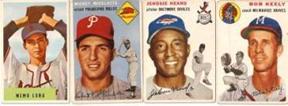 Both Topps and Bowman were starting to stretch to come up with their
“exclusives.” As kids we looked at these cards and said: “Who are these
guys?” Although the write-ups may have said that the player had “earned a
berth” with the big club after 11 years in the minors, they must have had their
“earnings” confiscated. The 1954
Bowman card of Memo Luna made me wonder at the time if this was a real guy or a
drawing. I assumed he was one of the players that never made it to “the show.”
Wrong again! Memo was up for 2/3rd of an inning with the Cardinals on
April 20, 1954, gave up 2 runs and disappeared. Some players had a cup of
coffee in the majors; Memo had a shot of espresso.
Both Topps and Bowman were starting to stretch to come up with their
“exclusives.” As kids we looked at these cards and said: “Who are these
guys?” Although the write-ups may have said that the player had “earned a
berth” with the big club after 11 years in the minors, they must have had their
“earnings” confiscated. The 1954
Bowman card of Memo Luna made me wonder at the time if this was a real guy or a
drawing. I assumed he was one of the players that never made it to “the show.”
Wrong again! Memo was up for 2/3rd of an inning with the Cardinals on
April 20, 1954, gave up 2 runs and disappeared. Some players had a cup of
coffee in the majors; Memo had a shot of espresso.
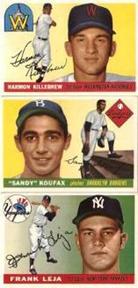 Topps rolled out (Od)bert Hamric as
a promising prospect for the ’55 Dodgers. He did indeed play for the Dodgers
that year getting into two games and striking out in his one at bat. He earned
a second and final trip to the “bigs” in 1958. To prove ’55 was no fluke he
batted eight more times and got a single as well as six more strikeouts. Let’s
take a look at some of the other guys who had cards and played in the majors
but few can say they saw them in action.
Topps rolled out (Od)bert Hamric as
a promising prospect for the ’55 Dodgers. He did indeed play for the Dodgers
that year getting into two games and striking out in his one at bat. He earned
a second and final trip to the “bigs” in 1958. To prove ’55 was no fluke he
batted eight more times and got a single as well as six more strikeouts. Let’s
take a look at some of the other guys who had cards and played in the majors
but few can say they saw them in action.
- Stan Jok, 1954 Topps and 1955 Bowman, 12 games in 2 years, 3 hits and one homer
- Frank Leja, 1954 and 1955 Topps, bonus baby, 1 hit in 23 at bats over 3 years
- Mickey Micelotta, 1954 Topps, 7 at bats with no hits in 2 years
- Paul Penson, another 1954 Topps Phillie, 16 innings pitched that year, gave up 14 hits and 14 walks
- Roy Hawes pictured on a 1955 Bowman, played only in 3 games, 6 at bats, one hit in 1951
- Steve Kraly, 1955 Topps, but pitched 5 games in ‘53
- Bob Ross, 1954 Topps, no games in 1954 but he did come back in ’56 to pitch 3 and 1/3 innings to finish a 20 game big league career
- Jake Rufus Crawford of the Tigers, 1955 Bowman. His only big league appearance however was a 7 game stint with the 1952 Browns where he got 2 hits in 11 at bats
- 1954 Topps “Jay” Jehosie Heard got in 2 games that year, pitched 3 and 1/3 innings giving up 6 hits, 5 runs, and 3 walks before disappearing
- 1954 Topps coach Bob Keely, the obscure players even had their own coach in Keely whose lifetime stat was one at bat for the 1945 Cardinals.
The teams agreed that, if they signed players to a bonus over a certain dollar amount, the player would have to remain on the franchise’s big league roster for two years, even though in most cases they weren’t seasoned enough (if ever) to play major league ball. A few players survived this rule like Sandy Koufax, Al Kaline, and Harmon Killebrew, but many rode the bench and then disappeared, like Tom Qualters and Frank Leja.
No Shows
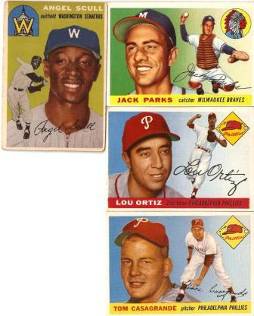 A few players pictured on cards
during these baseball “war” years never got to step on the field. Angel Scull is shown as a 1954 Senator on his
Topps card, but never played in the majors although he was inducted into the
Cuban Baseball Hall of Fame. Lou Ortiz had been in the minors since ’46 when he
was shown as a ’55 Phillie but never appeared in a major league game, nor did
would-be Phillie Tom Casagrande. Jack Parks toiled 11 years in the minors and
was rewarded with his own card as a Brave in 1955 and further immortalized
along with Ortiz in the Topps doubleheader set, however he never appeared in a
big league game either even though his card purports to show his big league
statistics. It is entirely possible that another player named “Red,” “Yo-Yo,”
Smith or Miller may have also dodged big league service despite having a card
during this period. Without sources like the Baseball Almanac only God and close relatives would know who got
into a game and who didn’t. Our memories wouldn’t help us much.
A few players pictured on cards
during these baseball “war” years never got to step on the field. Angel Scull is shown as a 1954 Senator on his
Topps card, but never played in the majors although he was inducted into the
Cuban Baseball Hall of Fame. Lou Ortiz had been in the minors since ’46 when he
was shown as a ’55 Phillie but never appeared in a major league game, nor did
would-be Phillie Tom Casagrande. Jack Parks toiled 11 years in the minors and
was rewarded with his own card as a Brave in 1955 and further immortalized
along with Ortiz in the Topps doubleheader set, however he never appeared in a
big league game either even though his card purports to show his big league
statistics. It is entirely possible that another player named “Red,” “Yo-Yo,”
Smith or Miller may have also dodged big league service despite having a card
during this period. Without sources like the Baseball Almanac only God and close relatives would know who got
into a game and who didn’t. Our memories wouldn’t help us much.
Thanks
Thanks to Baseball-Almanac.com and Baseball reference.com for their on-line information, to Ron Erbe for his 1982 book The American Premium Guide to Baseball Cards (a handy source for finding cards for each player), and the fellow collectors on my block as a kid who eventually traded me back all the cards I had traded them to get Ralph Kiner. If any readers have information to share on the cards or players from 1951 to 1955, please send me a note.
The graph shows that
players appearing in both sets declined and that Bowman was leading with more
players exclusively on their cards when Topps bought Bowman.
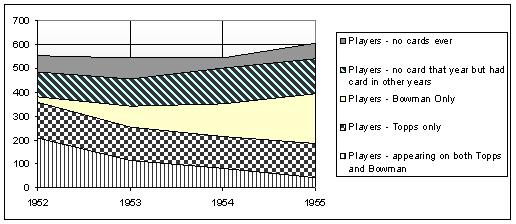
|
|
1952 |
1953 |
1954 |
1955 |
|
FOX |
B |
B |
B |
B |
|
FURILLO |
B |
B |
B |
B |
|
MAGLIE |
B |
B |
B |
B |
|
PIERSALL |
B |
B |
B |
B |
|
NEWCOMBE |
B |
|
B |
B |
|
YOST |
BT |
B |
B |
B |
|
KINER |
B |
BT |
B |
B |
|
CAMPANELLA |
BT |
BT |
B |
B |
|
FELLER |
BT |
BT |
B |
B |
|
MANTLE |
BT |
BT |
B |
B |
|
REESE |
BT |
BT |
B |
B |
|
COLEMAN |
BT |
|
B |
B |
|
MUSIAL |
B |
B |
|
|
|
FORD |
|
BT |
BT |
B |
|
CRANDALL |
T |
T |
BT |
B |
|
LAW |
BT |
|
BT |
B |
|
BOYER,
CLOYD |
T |
BT |
|
B |
|
BERRA |
BT |
BT |
BT |
BT |
|
RIZZUTO |
BT |
BT |
BT |
BT |
|
MATTHEWS |
T |
BT |
BT |
BT |
|
MAYS |
BT |
T |
BT |
BT |
|
AARON |
|
|
T |
BT |
|
KALINE |
|
|
T |
BT |
|
MARTIN |
T |
BT |
BT |
|
|
O'BRIENS |
|
T |
T |
|
|
NEWHOUSER |
|
T |
|
T |
|
SNIDER |
BT |
B |
BT |
T |
|
WILLIAMS |
|
|
(B)T |
T |
|
SPAHN |
BT |
BT |
T |
T |
|
KLUSZEWSKI |
T |
BT |
T |
T |
|
GROAT |
T |
T |
T |
T |
|
ROBINSON,
J |
T |
T |
T |
T |
|
|
|
|
|
|
|
T= Topps
card issued that year |
|
|
||
|
B= Bowman
Card issued that year |
|
|||
|
Gray
background = Not in majors that year |
||||
Bowman exclusives are
at the top of the chart, Topps exclusives at the bottom. The companies fought
it out over the players in the middle.
George Vrechek is a freelance
contributor to SCD and can be reached at vrechek@ameritech.net
A big OBC thank you to Sports Collectors
Digest (SCD) for allowing us to reprint George's article here on the OBC
site!